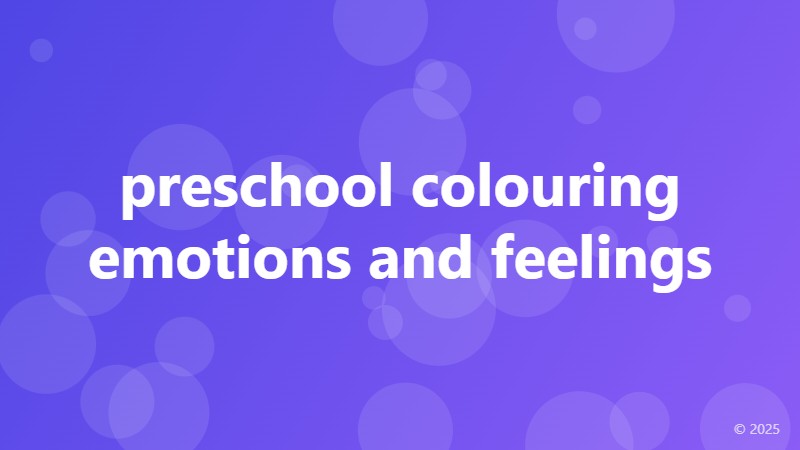preschool colouring emotions and feelings

Unlocking Emotional Intelligence in Preschoolers through Colouring Emotions and Feelings
Preschool years are a critical period in a child's emotional development. It's essential to introduce them to emotional intelligence concepts to help them navigate their feelings and develop empathy towards others. One innovative way to achieve this is by incorporating colouring emotions and feelings into their preschool curriculum.
Why Colouring Emotions and Feelings Matter in Preschool Education
Colouring emotions and feelings is more than just a fun activity; it's a powerful tool for teaching preschoolers to recognize, understand, and manage their emotions. By using colours to represent different feelings, children can begin to develop an emotional vocabulary, enabling them to express themselves more effectively. This, in turn, helps them build stronger relationships with their peers and caregivers.
Moreover, colouring emotions and feelings can help preschoolers develop self-awareness, a crucial aspect of emotional intelligence. By identifying and labelling their emotions, children can better understand what they're feeling and why, making it easier for them to regulate their emotions and respond to situations more appropriately.
How to Incorporate Colouring Emotions and Feelings into Preschool Activities
Integrating colouring emotions and feelings into preschool activities is easier than you think. Here are some ideas to get you started:
Create a "Feelings Chart": Develop a chart with different emotions (e.g., happy, sad, angry, scared) and corresponding colours. Have children colour the emotion they're feeling, encouraging them to explain why they chose that particular colour.
Colouring Emotion Masks: Provide children with emotion masks (e.g., smiley face, frowning face) and a variety of colours. Ask them to colour the mask according to how they're feeling, then discuss their choices as a group.
Emotion-themed Colouring Pages: Design colouring pages with scenarios depicting different emotions (e.g., a child crying, a child playing with friends). Have children colour the page according to how they would feel in that situation.
The Benefits of Colouring Emotions and Feelings in Preschoolers
Incorporating colouring emotions and feelings into preschool activities can have a profound impact on a child's emotional development. Some benefits include:
Improved Emotional Regulation: Colouring emotions and feelings helps preschoolers develop self-awareness, enabling them to better regulate their emotions and respond to situations more appropriately.
Enhanced Empathy: By understanding and identifying with others' emotions, preschoolers develop empathy, a crucial social skill for building strong relationships.
Better Communication: Colouring emotions and feelings encourages preschoolers to express themselves more effectively, reducing frustration and tantrums.
In conclusion, colouring emotions and feelings is a valuable tool for teaching preschoolers about emotional intelligence. By incorporating this activity into their curriculum, caregivers and educators can help children develop essential social and emotional skills, setting them up for success in school and beyond.